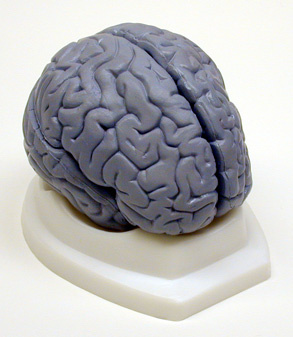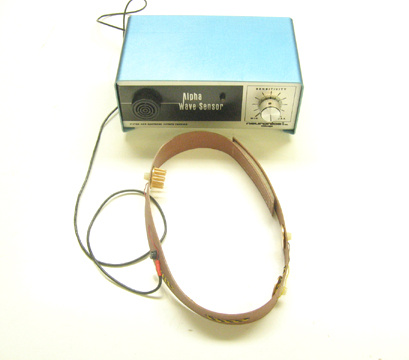Breadcrumb
11A10.20 - Model of the Human Brain

|
|

|

|
|
Code Number: 11A10.20
Demo Title: Model of the Human Brain
Condition: Good
Principle: Physiology
Area of Study: Physiology, Biology
Equipment: Human Brain Model.
Procedure:
No advanced notice required. Parts of the brain are numbered and an explanation of these parts can be found in the file. The laser etched crystal cube while small is a very good example of the brain network.
The Alpha Wave detector will show one aspect of brain function if operated properly.
References:
- Peter S. Given Jr., "Studying the Brain's Alpha Wave Patterns in a High School Laboratory", TPT, Vol. 10, #2, Feb. 1972, p. 93.
- Maurice M. Klee, "A Charge Analysis of Non-Invasive Electrical Brain Stimulation", AJP, Vol. 91, #4, April 2023, p.264.
- Barry Horwitz, "Physics Course on Information Processing in the Nervous System", AJP, Vol. 42, #3, Mar. 1974, p. 198.
- Sam Van Wassenbergh, Maja Mielke, "Why Woodpeckers Don't Get Concussions", Physics Today, Vol. 77, #1, Jan. 2024, p. 54.
- Toni Feder, "Neuroscientists Network to Study the Whole Brain", Physics Today, Vol. 71, #5, May 2018, p. 26.
- R. Mark Wilson, "Imaging A Mouse's Brain Through its Skull", Physics Today, Vol. 68, #9, Sep. 2015, p. 14.
- Charles Day, "Toward Imaging the Brain's Tiniest Arteries", Physics Today, Vol. 67, #1, Jan. 2014, p. 16.
- Toni Feder, "Putting Heads Together for Concussion Research", Physics Today, Vol. 66, #12, Dec. 2013, p. 23.
- Toni Feder, "The Brain is Big Science", Physics Today, Vol. 66, #12, Dec. 2013, p. 20.
- Front Cover Page, Physics Today, Vol. 66, #12, Dec. 2013.
- Johanna L. Miller, "New Technique Makes Brains Transparent", Physics Today, Vol. 66, #6, June 2013, p. 14.
- Humberto Mestre Et al., "Cerebrospinal Fluid Influx Drives Acute Ischemic Tissue Swelling", Science, Vol. 367, # 6483, March 13, 2020, p. 1211.
- "CLARITY Makes it Perfectly Clear", Science, Vol. 342, #6165, Dec. 2013, p. 1434.
- Robert J. Zatorre, "Predispositions and Plasticity in Music and Speech Learning: Neural Correlates and Implications", Science, Vol. 342, #6158, Nov. 2013, p. 585.
- Nicholas B. Turk-Browne, "Functional Interactions as Big Data in the Human Body", Science, Vol. 342, #6158, Nov. 2013, p. 580.
- Hae-Jeong Park and Karl Friston, "Structural and Functional Brain Networks: From Connections to Cognition", Science, Vol. 342, #6158, Nov. 2013, p. 579.
- Nikola T. Markov, Mária Ercsey-Ravasz, David C. Van Essen, Kenneth Knoblauch, Zoltán Toroczkai, and Henry Kennedy, "Cortical High-Density Counterstream Architectures", Science, Vol. 342, #6158, Nov. 2013, p. 578.
- Peter Stern, "Connection, Connection, Connection...", Science, Vol. 342, #6158, Nov. 2013, p. 577.
- Emily Underwood, "Short-Circuiting Depression", Science, Vol. 342, #6158, Nov. 2013, p. 548.
- Front Cover Page, Science, Vol. 342, #6158, Nov. 2013.
- Mitchell Glickstein and Alan R. Gibson, "Visual Cells in the Pons of the Brian", Scientific American, Vol. 235, #5, Nov. 1976, p. 90.
- Rodolfo R. Llinás, "The Cortex of the Cerebellum", Scientific American, Vol. 232, #1, Jan. 1975, p. 56.
- Lennart Heimer, "Pathways in The Brain", Scientific American, Vol. 224, #1, July 1971, p. 48.
- Lydia Chain, "Trojan Horse in the War on Cancer", Popular Science, Vol. 288, #2, Mar/Apr. 2016, p. 26.
- Matt Giles, "Big Idea: The Brain's Best-Kept Secret" Popular Science, Vol. 288, #1, Jan/Feb 2016, p. 46.
- Joe DeLessio, "Tackling Brain Trauma Head-On", Popular Science, Vol. 288, #1, Jan/Feb 2016, p. 32.
- Megan Scudellari, "10 Brain Myths Busted", Popular Science, Vol. 287, #5, Nov. 2015, p. 48.
- Daniel Engber, "Why Don't Woodpeckers Get Brain Damage?", Popular Science, Vol. 286, #9, Sept. 2014, p. 79.
- Adam Piore, "The Neuroscientist Who Wants To Upload Humanity To A Computer", Popular Science, Vol. 286, #5, May 2014, p. 54.
- Mary Beth Griggs, "When Brain Cells Excite", Popular Science, Vol. 286, #5, May 2014, p. 35.
- Virginia Hughes, "Stop Looking for 'Hardwired' Differences in Male and Female Brains", Popular Science, Vol. 286, #4, Apr. 2014, p. 34.
- Erik Sofge, "Computers Decode our Brains", Popular Science, Vol. 286, #1, Jan 2014, p. 46.
- Pat Murphy, Ellen Macaulay, and the Staff of The Exploratorium, "Your Brain", Exploratopia, p. 67 - 81.
- "Brainiac", Uncle John's Bathroom Reader, p. 264.
- Vicki Cobb and Kathy Darling, "Write Wrong", Bet You Can!, p. 16.
- Janice VanCleave, "3. Brainpower", The Human Body for Every Kid, p. 21 - 27.
- Curt Suplee, "Emotion and Memory", Everyday Science Explained, National Geographic, p. 260 - 261.
- Curt Suplee, "Basics of the Brain", Everyday Science Explained, National Geographic, p. 244 - 245.
- Curt Suplee, "Of Heart Attacks and Brain Attacks", Everyday Science Explained, National Geographic, p. 230 - 231.
- Curt Suplee, "The Control Center", Everyday Science Explained, National Geographic, p. 222 - 223.
- Ron Hipschman and Jad King, "Recipe No. 111: Mirrorly A Window", Exploratorium Cookbook II, p. 111-1 - 111-4.
- Sara Stein, "Thoughts", The Science Book, p. 244.
- Sara Stein, "Your Secret Face", The Science Book, p. 254.